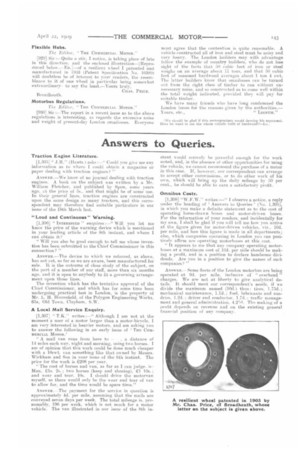Answers to Queries.
Page 17

If you've noticed an error in this article please click here to report it so we can fix it.
Traction Eagine Literature.
[1,395] " J.R." (Hants. asks :--" Could you give me any information as to where I could obtain a magazine or paper dealing with traction engines? "
ANSwER.—We know of no journal dealing with traction engines. A book on the subject was written by a Mr. William Fletcher, and published by Spon, some years ago, at the price of Sc.. and that might be of some use. In their general lines, traction engines are constructed upon the same design as many tractors, and this correspondentmay therefore find suitable particulars in our issue of the 18th March last.
"Loud and Continuous" Warning.
[1,396] " INTERESTED 77 enquires:--" Will you let me know the price of the warning device which is mentioned in your leading article of the 8th instant, and where I can obtain it
" Will you also he good enough to tell me whose invention has been submitted to the Chief Commissioner in this connection? "
ANSWER.—The device to which we referred, as above, has not yet, so far as we are aware, been manufactured for sale. It is the outcome of close study of the subject, on the part of a member of our staff, more than six months ago, and it is open to anybody to fit a governing arrangement upon those lines.
The invention which has the tentative approval of the Chief Commissioner, and which has for some time been undergoing practical test in London, is the property of Mr. L. H. Hounsfield, of the Polygon Engineering Works, 63a, Old T(■wii. Clapham .W A Local Mail Service Enquiry.
[1,397] " T.K." writes :—" Although I am not at the moment a user of a motor larger than a motor-bicycle, I am very interested in heavier motors, and am asking you to answer the following in an early issue of Tlis: CostMERCIAL MOTOR.'
" A mail van runs from here to , a distance of 14 miles each way, night and morning, using two horses. I am of opinion that this work could be done much cheaper with a. lOcwt. van something like that owned by Messrs. Wickham and Son in your issue of the 8th instant. The price for the work is E208 per year.
"The cost of horses and van, as far as I can judge. is 7 Man, Els. 2s.; two horses (keep and shoeing), El 10s.; and wear and tear, 10s. I should drive the motorvan myself, so there would only be the wear and tear of van to allow for, and the time would be spare time."
ANSwER.--The payment for the service in question is approximately 4d. per mile, assuming that the mails are conveyed seven days per week. The total mileage is, presumably, 196 per week, which is not much for a motor vehicle. The van illustrated in our issue of the 8th in stant would scarceiy he powerful enough for the work noted, and, in the absence of other opportunities for using the vehicle, we cannot recommend the purchase of a motor in this case. If, however, our correspondent can arrange to accept other commissions, or to do other work of his own, which will bring up the daily mileage by 50 per cent., he should be able to earn a satisfactory profit.
Omnibus Costs.
[1,398] "W.F.W." writes:—' I ohserve a notice, a reply under the heading of Answers to Queries ' (No. 1,391), in which you make a definite statement as to the cost of operating horse-drawn buses and motor-driven buses. For the information of your readers, and incidentally for my own, I shall be glad if you will tell me how you arrive at the figure given for motor-driven vehicles, viz.. 10d. per mile, and how this figure is made in all departments; also, which companies operating in London you can positively affirm are operating motorbuses at this cost.
" It appears to me that any company operating motorbuses at a maximum cost of lad, per mile should be making a profit, and in a position to declare handsome dividends. Are you in a position to give the names of such companies? "
Asisws.e.— Some fleets of the London motorbus are being operated at 9d. per mile, inclusive of " overhead " charges. We are not at liberty to give analytical details. It should meet our correspondent's needs, if we divide the maximum named (10d.) thus: tires, 1.75d. ; mechanical maintenance, 1.1d.; fuel, lubricants and sundries. 1.2d.; driver and conductor, 1.7d.: traffic management and general administration. 4.2".z,1. The making of a profit depends on revenue and on the existing general financial position of any company.




















